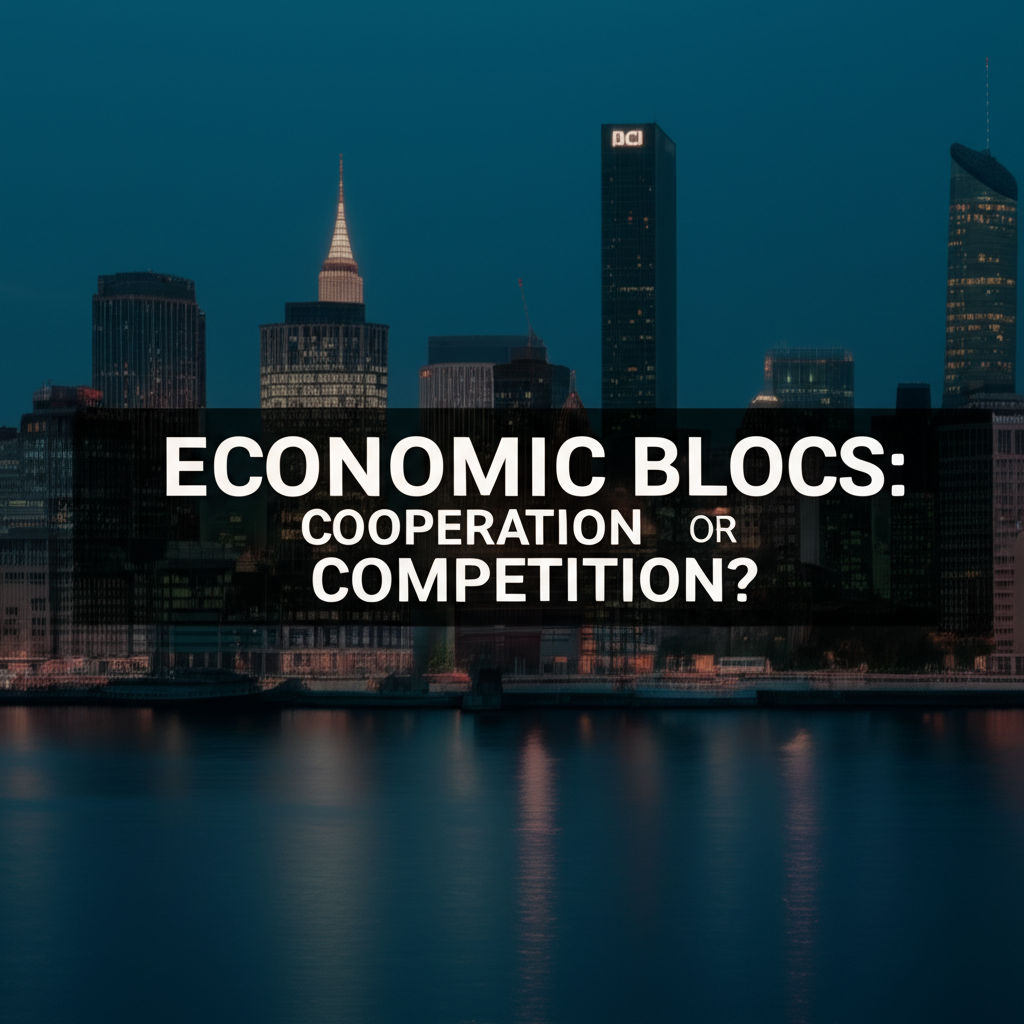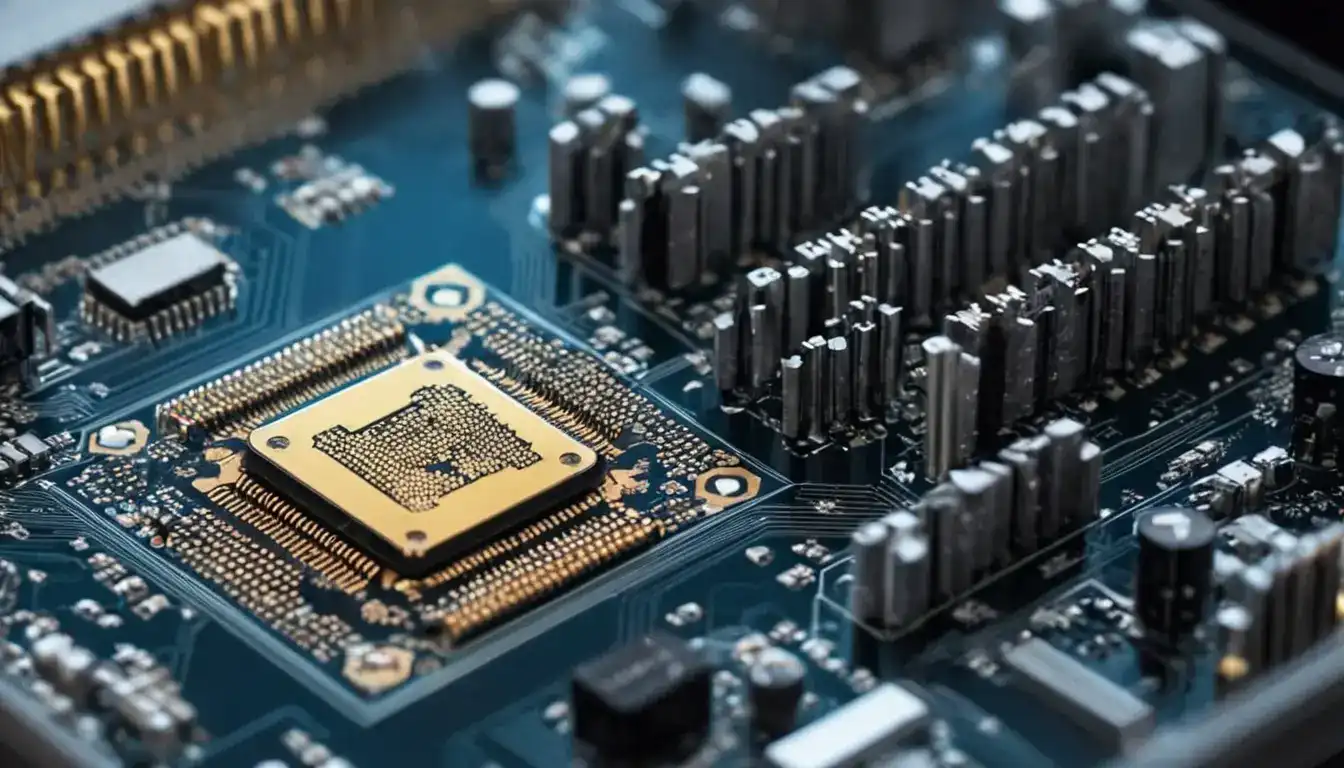Economic Blocs: Cooperation or Competition?
Emily Willis

Photo: Economic Blocs: Cooperation or Competition?
Economic Blocs: Navigating the Tides of Cooperation and Competition in a Globalized World
In an increasingly interconnected world, the concept of economic blocs has become central to understanding global trade dynamics. These powerful alliances of nations, driven by shared economic interests, promise a future of enhanced cooperation and prosperity. Yet, they also introduce complexities, raising questions about potential competition and fragmentation within the global marketplace. For a general audience, understanding these intricate relationships is crucial, as their impact ripples through everything from the prices we pay for goods to international relations.
What Exactly Are Economic Blocs? A Closer Look at Their Forms
At its core, an economic bloc, also known as a trade bloc, is a multilateral agreement between countries designed to facilitate trade and foster deeper economic integration among its members. These alliances typically focus on reducing or eliminating trade barriers like tariffs, quotas, and import restrictions, making it easier and cheaper for member countries to exchange goods and services. The ultimate aim is to create a larger, more efficient marketplace that encourages investment, drives economic growth, and enhances cooperation.
Economic blocs vary significantly in their level of integration, ranging from basic preferential agreements to highly integrated economic unions. Here are the main types:
- Preferential Trading Areas (PTAs): This is the simplest form, where member countries agree to reduce tariffs on certain goods, but not necessarily eliminate all trade barriers. An example is the PTA between India and Chile.
- Free Trade Areas (FTAs): In an FTA, member nations eliminate most trade barriers among themselves, but each country retains its own independent trade policies with non-member nations. The United States-Mexico-Canada Agreement (USMCA), which succeeded NAFTA, is a prominent example.
- Customs Unions (CUs): Building on an FTA, a customs union not only removes internal trade barriers but also establishes a common external tariff policy for trade with non-member countries. This prevents "trade deflection," where goods enter the bloc through the country with the lowest external tariff and then move freely within the bloc.
- Common Markets: This level of integration includes all features of a customs union and additionally allows for the free movement of factors of production—namely, labor, capital, and enterprise—among member countries. Mercosur, comprising Argentina, Brazil, Paraguay, and Uruguay, is an example.
- Economic Unions: Representing the highest level of integration, economic unions combine all aspects of a common market and further incorporate common economic institutions and coordinated economic policies, including fiscal and monetary policies. The European Union (EU) is the most advanced example, even featuring a monetary union (the Eurozone) with a common currency.
Some of the most impactful economic blocs today include the EU, USMCA, the Association of Southeast Asian Nations (ASEAN), Mercosur, and the African Continental Free Trade Area (AfCFTA). These blocs collectively facilitate a significant portion of global commerce, reshaping international trade patterns.
The Case for Cooperation: How Blocs Foster Shared Prosperity
The formation of economic blocs is often lauded for its potential to foster cooperation and bring about substantial economic benefits for member states.
- Increased Trade and Economic Growth: By reducing or eliminating internal tariffs and non-tariff barriers, economic blocs make it easier and cheaper for member countries to trade with each other. This leads to increased trade volumes, expanded market access, and ultimately, economic growth. Firms can achieve economies of scale by producing for a larger market, leading to lower production costs and more competitive prices.
- Enhanced Bargaining Power: A unified bloc holds greater negotiating power on the global stage compared to individual nations. This stronger collective voice allows them to secure more favorable trade agreements and policies with non-member countries or other blocs. For instance, the EU's collective bargaining power in trade disputes is a significant advantage.
- Peace and Stability: Economic interdependence fostered by trade blocs can significantly reduce the likelihood of conflicts between member nations. As economies become intertwined, countries have a greater vested interest in maintaining stable and cooperative relationships.
- Shared Standards and Regulations: Blocs often work towards harmonizing standards, regulations, and customs procedures. This simplification reduces bureaucratic hurdles, streamlines supply chains, and fosters a more predictable business environment, which in turn attracts foreign direct investment.
- Innovation and Knowledge Transfer: By facilitating knowledge sharing, technological cooperation, and the joint development of productive capacities, economic blocs can act as catalysts for innovation and efficiency among member countries.
The European Union stands as a prime example of successful economic cooperation. Its single market allows for the free movement of goods, services, capital, and people, leading to significant economic integration and mutual benefits among its 27 member countries.
The Flip Side: When Economic Blocs Fuel Competition and Conflict
While the benefits of cooperation within economic blocs are clear, their existence also introduces dynamics of competition and potential conflict, particularly with countries outside the bloc.
- Trade Diversion and Protectionism: One significant concern is "trade diversion." This occurs when member countries shift their trade from more efficient, lower-cost non-member countries to higher-cost member countries, simply because tariffs are eliminated within the bloc. This can lead to inefficiencies and higher prices for consumers overall. It can also protect inefficient domestic industries within the bloc from external competition.
- Exclusion of Non-Members: Economic blocs inherently create preferential treatment for their members, which can disadvantage non-member countries. This can lead to reduced market access and decreased export demand for external nations, potentially deteriorating their terms of trade and market power.
- Geopolitical Rivalries and Trade Wars: The formation of large, powerful economic blocs can intensify geopolitical tensions. Countries excluded from major blocs may feel compelled to form their own alliances or resort to protectionist measures in retaliation, potentially escalating into trade wars. The ongoing strategic rivalry between major global powers, often manifesting in trade disputes, highlights this competitive aspect.
- Loss of Sovereignty: Member countries, especially smaller ones, may experience a loss of sovereignty in their trade policy decisions, as they must align with the bloc's common regulations and external policies. This can sometimes conflict with specific national economic interests.
- Increased Interdependence and Contagion: While interdependence can foster peace, it also means that economic problems or crises in one member country can quickly spread to others within the bloc, amplifying their impact.
The implications of such competitive dynamics are increasingly evident in the global supply chain landscape. Geopolitical tensions and the push for regional self-sufficiency are leading businesses to rethink their supply chain strategies, sometimes moving away from cost-optimized global networks towards more regionalized or "friendshored" models to reduce exposure to cross-border disruptions.
Navigating the Dynamics: Balancing Cooperation and Competition
The interplay between cooperation and competition within and around economic blocs is a defining feature of the modern global economy. Successfully navigating this complex landscape requires a multifaceted approach.
- The Role of Multilateral Organizations: Global organizations like the World Trade Organization (WTO), the International Monetary Fund (IMF), and the World Bank play a crucial role in promoting a rules-based global trading system and fostering broader international cooperation. However, the rise of regionalism and increasing protectionist pressures have sometimes challenged the effectiveness of these multilateral institutions, highlighting a need for greater coordination between regional blocs and global bodies.
- Strategies for Non-Members: For countries outside major blocs, strategies for maintaining trade relations include pursuing bilateral agreements, seeking observer status, or adapting their industries to become indispensable suppliers to bloc members. Diversifying trade partners and fostering resilience in supply chains are also key.
- Adapting to Evolving Global Supply Chains: Businesses must strategically adapt to the reconfigured global supply chain landscape. This includes focusing on building stronger local supplier networks, exploring dual-sourcing strategies, and potentially near-shoring production facilities closer to end markets to mitigate risks associated with geopolitical tensions and trade restrictions.
- The Future of Economic Blocs: The future of economic blocs will likely involve continued evolution. We may see existing blocs deepen their integration, new blocs emerge, and increased focus on digital trade regulations and sustainability standards within these agreements. The balance between economic prosperity and geopolitical influence will continue to shape their trajectory.
Actionable Insights for a Globalized Economy
Understanding the dynamics of economic blocs is not just an academic exercise; it has real-world implications for businesses, policymakers, and individuals.
-
For Businesses:
- Market Access & Compliance: Thoroughly understand the regulatory frameworks and trade policies of the economic blocs relevant to your target markets. This includes tariffs, product standards, and rules of origin.
- Supply Chain Resilience: Diversify your supply chain beyond single regions or countries. Consider "China+1" strategies or near-shoring to build resilience against geopolitical disruptions and trade restrictions.
- Strategic Partnerships: Explore partnerships with companies or entities within target economic blocs to navigate market entry and leverage local expertise.
- Digital Trade Awareness: Stay updated on evolving digital trade regulations and e-commerce provisions within various blocs, as these increasingly govern cross-border digital services and data flows.
-
For Policymakers:
Latest ✨
View AllMaster the art of handling complaints effectively. Learn the psychology, actionable steps, and how to turn feedback into opportunities for growth and stronger r...
Emily Willis
Women's participation in sport has evolved into a powerful movement that challenges societal norms, empowers individuals, and promotes inclusivity. This article explores the journey of women in sport, highlighting their achievements, the obstacles they have overcome, and the transformative impact they continue to have in the world of sport and beyond.
Emily Willis
Beyond crypto hype: Understand digital asset economics. Learn core principles like supply, demand, scarcity & utility to navigate the market wisely.
Emily Willis
Redefining success in education means moving beyond grades. Learn how future outcomes focus on adaptability, critical thinking, and skills for an unpredictable...
Emily Willis
Business
View All
June 9, 2025
Risk Management: Protect Your BusinessUnlock business resilience! Master risk management to protect assets, enhance decision-making, minimize losses, and ensure sustainable growth in an uncertain wo...
Emily Willis

June 8, 2025
Entrepreneurial Journey to SuccessDemystify the entrepreneurial journey. This guide offers actionable strategies to transform ideas into thriving businesses, navigate challenges, and achieve las...
Emily Willis

June 8, 2025
Personalization in Business MarketingUnlock business growth! Learn how personalized marketing transforms interactions, boosts engagement & loyalty by speaking directly to your customers.
Emily Willis
Economy
View AllBuild your financial future! Demystify investing with smart, accessible strategies & practical tips for everyone to grow lasting wealth.
Read MoreInfrastructure development is crucial for driving economic growth and regional integration by improving connectivity, facilitating trade, and enhancing quality of life. Investments in transportation networks and digital infrastructure support businesses in accessing larger markets and capitalizing on trade opportunities. Well-developed infrastructure simplifies trade processes and attracts industries to specific regions, promoting economic development. Access to essential services and urban infrastructure improves quality of life and fosters sustainable urbanization. Green infrastructure projects support environmental conservation and contribute to sustainable development goals. Overall, strategic investments in infrastructure are essential for building resilient, inclusive, and prosperous communities in the global economy.
Read MoreUnlock historical wisdom and ancient philosophies for preventing depression. Learn timeless strategies for resilience and emotional balance in modern life.
Read MoreEntertainment
View All
August 5, 2024
Arts Education's Importance: Nurturing Creativity and Fostering ExpressionArts education is often overlooked in a world focused on standardized tests and STEM subjects, but it plays a vital role in nurturing creativity, self-expression, and essential skills in students. Arts education allows students to unleash creativity, build confidence, improve communication and collaboration skills, develop critical thinking and problem-solving abilities, increase cultural awareness and appreciation, and enhance emotional intelligence.
Emily Willis

August 5, 2024
Music Universal Language: Connecting and Inspiring Across CulturesMusic has the power to transcend language barriers and connect people on a deep emotional level. It serves as a bridge between cultures, fostering understanding and appreciation for diversity. The universality of rhythm and melody creates a sense of unity, while the diversity of musical styles allows for exploration and creativity.
Emily Willis

August 4, 2024
The Evolution of Digital Distribution in the Music Industry: Challenges and OpportunitiesThe music industry has been transformed by digital distribution, which allows quick access to a vast catalog of music through streaming services and online stores.
Emily Willis
Health
View AllRegular physical activity is crucial for maintaining long-term health and well-being. It has numerous benefits, including improving cardiovascular health, aiding in weight management, enhancing mental health, strengthening bones, boosting immune function, and promoting longevity.
Emily Willis
our minds are often overwhelmed with information and stimuli, leading to stress and anxiety. Mindfulness and meditation offer tools to cultivate inner peace and well-being. Mindfulness involves being present in the moment without judgment, while meditation involves focusing attention on an object or thought.
Emily Willis
Maintaining good health involves a balanced diet that provides essential nutrients for the body. A balanced diet includes carbohydrates, proteins, fats, vitamins, minerals, fiber, and water. Benefits of a balanced diet include enhanced energy levels, improved mental health, a stronger immune system, better weight management, reduced risk of chronic diseases, and enhanced digestion. Components of a balanced diet include fruits and vegetables, whole grains, protein sources, dairy or dairy alternatives, and healthy fats. Tips for maintaining a balanced diet include planning meals, portion control, staying hydrated, limiting processed foods, eating mindfully, and including physical activity.
Emily Willis
Trending 🔥
View All
1
3
4
5
7
8
9
10
Sports
View AllAugust 4, 2024
The Importance of Mental Training and Psychological Strategies in Helping Athletes Reach Their Peak Performance on the Field
Read MoreAugust 5, 2024
The Future of Sports: Anticipating Trends, Embracing Innovation, Shaping a New Era
Read MoreAugust 4, 2024
Sports Technology Innovation: Revolutionizing Training and Performance Analysis
Read MoreTechnology
View All
August 4, 2024
Exploring the Potential of Quantum Computing in Modern Technology
Quantum computing is a revolutionary technology that uses quantum bits, or qubits, to process information. It has the potential to solve complex problems, revolutionize cryptography, accelerate drug discovery, optimize complex systems, and enhance artificial intelligence.

August 5, 2024
Tips for Implementing Cloud Computing Safely and Efficiently
Cloud computing is essential for modern businesses, offering cost savings, scalability, and improved collaboration. Implementing cloud computing requires careful planning to ensure safety and efficiency. Tips for safe and efficient implementation include conducting a needs assessment, choosing the right cloud service model, prioritizing security, planning for data migration, optimizing costs, training your team, implementing backup and recovery solutions, monitoring performance, planning for scalability, and staying updated with industry trends.

August 5, 2024
Oculus Quest 2 vs HTC Vive Pro – Which Should You Choose?
Oculus Quest 2 vs HTC Vive Pro – which VR headset reigns supreme? Dive into this ultimate showdown to discover the strengths and weaknesses of each, and decide which one is worth your investment. From specs and comfort to content and price, we'll help you make an informed choice.

August 5, 2024
AI Applications that are Changing the World Around Us
Artificial Intelligence (AI) is no longer a concept from science fiction, but a reality that is reshaping the world around us. From virtual assistants to self-driving cars, AI is making significant impacts in various industries such as healthcare, education, transportation, and agriculture. AI is also being used to address environmental challenges and enhance customer experiences.





















